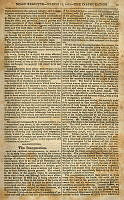The Inauguration of John Quincy Adams
This article is about the Inauguration of President John Quincy Adams and was published in Niles' Weekly Register on March 12, 1825. The article describes the events of the Inauguration and Adams's outfit which was a "plain suit of black". John Quincy Adams was the son of President John Adams and First Lady Abigail Adams. Prior to his presidency, President Adams was a diplomat to the Netherlands, Prussia, Russia, and the United Kingdom. He served as Secretary of State under President James Monroe and is the only president who went on to serve in the United States House of Representatives after being president. Adams represented his home state, Massachusetts, in the House.
